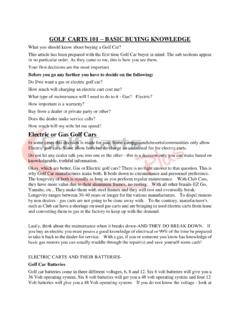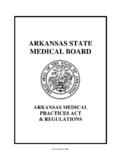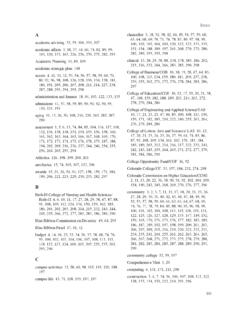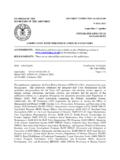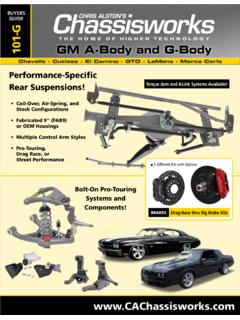Transcription of DESIGN MANUAL NO. 101/o SOVENT
1 DESIGN MANUAL NO. 101/o SOVENT Single Stack DWV System SESCO TECHNICAL SUPPORT Tel 954-785-0508 Fax 954-785-5123 TABLE OF CONTENTS Introduction How System Works SOVENT DESIGN Requirements A) SOVENT Stack & Aerator B) Deaerator & Building Drain C) Branches Aerator Dimensions Deaerator Dimensions Fixture Unit Values Table A Maximum Stack Loading Table B Building Drain Loading Table C Branch Loading Table D Rules Illustrated 1-1 1-2 1-3 1-3 1-4 1-5 1-6 1-7 1-8 1-9 1-9 1-9 1-10 The SOVENT System is an engineered single stack drainage system that offers the industry its first major change in many years. It offers a different concept of waste and venting by slowing the velocity of the liquids and solids through a series of aerator fittings and double offsets. Before entering the building drain a deaerator fitting is placed at the base of the stack to minimize solid build up and slow the drainage before entering the building drain.
2 This fitting is designed to have a pressure relief line which is to extend back (10) ten pipe diameters and tied into the building drain. This eliminates any back pressure problems. As in all industries, especially the plumbing industry, something new can be very hard to accept. SOVENT on the other hand offers an exciting new approach to the DESIGN and installation of sanitary plumbing systems with obvious savings in labor, material and construction. INTRODUCTION TO CAST IRON SOVENT SYSTEMS Page 1-1 THE CAST IRON SOVENT SYSTEM: HOW IT PERFORMS The cast iron SOVENT is a specially designed single stack soil and waste system using aerator fittings at each floor where soil and waste branches enter the stack and deaerator fittings at the base of the stack. By incorpo-rating these fittings into a single multi-story stack the volume of the drainage is greatly increased over the standard two stack waste and vent system. The aerator fitting is designed with an offset chamber that slows the Soil and waste matter at each floor, never allowing it to reach its terminal veloc-ity thus eliminating back pressure.
3 The deaerator fitting at the base of the stack is designed to eliminate any build up of solids and slows the con-tents before the change of direction. At the base of the stack the pressure relief line eliminates any pressure build up which might occur. This fit-ting is designed to assure a smooth drainage flow from the vertical stack into the horizontal drain. The loop in the pressure relief line accommo-dates hydraulic jump that occurs at the base of the stack. Page 1-2 RULES FOR SOVENT STACK AND AERATOR connected to the horizontal off-set between the vertical stack and termination of the pressure relief line. The horizontal pipe more than sixty degrees shall be sized by table C , and also may require resizing of stack. Refer to table B. (dwg. 101-2) The house drain system is sized by combining all vertical stack fixture loads as they connect to system and as per prevailing plumbing code.
4 Stacks may offset above the highest fixture. When the hori-zontal offset exceeds 20 -0 , the diameter of the horizontal offset and the VTR must be increased one pipe size. (dwg. 101-4) Stacks may be connected to-gether above highest fixture be-fore extending through the roof. The combined vertical stack must be one (1) pipe size larger than any of the combined stacks. If the distance between two (2) stacks to be connected is greater than twenty feet (20 -0 ) the hori-zontal branch must be one (1) pipe size larger than the down-stream stack. (dwg. 101-3) The stack must be sized by fix-ture unit load using table B. The stack shall continue through the roof full size, or per rule A8. (dwg. 101-4) Aerator fittings are required at each floor when horizontal branches enter the stack as fol-lows: a. Soil branch b.
5 Soil branch same size as stack c. Waste branch one (1) pipe size smaller than stack. A double in line offset may be used where an aerator is not re-quired. The distance between the aerator and double offset is 20 -0 maximum with no more than two (2) consecutive in line offsets al-lowed. (dwg. 101-1) A waste branch two (2) sizes smaller than the stack may be connected directly to the stack without an aerator fitting by using sanitary fittings. (dwg. 101-8b) Stack offsets of more than sixty degrees require a deaerator fitting and pressure relief line. Soil or waste branches can be A1. A2. A3. A4. A5. A6. A7. A8. A9. Page 1 3 THE DEAERATOR AND BUILDING DRAIN The deaerator fitting must be in-stalled at the base of the vertical stack before it enters the horizon-tal building drain.
6 If the vertical distance to the closest aerator or double in line offset exceeds twenty feet (20 -0 ) an in line off-set must be installed within five feet (5 -0 ) above the deaerator. (dwg. 101-5) A pressure relief line shall extend from the deaerator and connect to the horizontal building drain at a minimum 10 pipe stack diameters from the center line of the stack to connection point. The pressure relief line may run parallel to the horizontal drain and must be above the center line. The pres-sure relief line is connected to the building drain above the center line. (dwg. 101-5) Soil and waste connections be-tween the center line of the SOVENT stack and termination point in the building drain is al-lowed. Connections must be made above the center line of the building drain, or the connections can be made 10 stack pipe diame-ters down stream.
7 (dwg. 101-6b) Waste branches connected to the pressure relief line shall be one (1) pipe size smaller . No connec-tions should be made in the verti-cal run of the pressure relief line. Battery type installations and clothes washers should not be connected to the pressure relief line. (dwg. 101-6b) Connections of soil and waste branches may be made down stream of the pressure relief line. Conventional plumbing rules ap-ply. Vents from these lines may tie into the SOVENT stack. (dwg. 101-7) Soil or waste branches may be connected directly into the verti-cal stack below the deaerator. The connections shall be made using sanitary fittings. Connec-tions of the stack to the building drain shall be made using combi-nation wye & 1/8 bend or conven-tional plumbing practices. Check prevailing code. Remote fixtures from the SOVENT stack where space or other con-ditions become a problem may be connected by conventional plumbing practice with the waste and vent sized by prevailing code.
8 B1. B2. B3. B4. B5. B6. B7. Page 1- 4 RULES FOR BRANCHES Maximum developed length of soil branches. A 3 soil branch shall not exceed twelve feet (12 -0 ). A 4 soil branch shall not ex-ceed twenty-seven feet (27 -0 ). The vertical drops from trap arms or fixture are not included in the maximum developed lengths. (dwg. 101-8) The maximum developed length of a 2 waste branch from the stack shall not exceed fifteen feet (15 -0 ). Waste branches must be two (2) pipe sizes smaller than the stack they are connected to. Ver-tical drops from trap arms or fix-tures not included in developed lengths. (dwg. 101-8 & 101-9) When three (3) ninety degree changes of direction occur in a branch the size must be in-creased one (1) pipe size at the ninety degree closest to the stack.
9 If on of the ninety degree can be made using two (2) one eighth (1/8) bends (or 45 degree bends) or short sweep then the size increase does not apply. Any connection from horizontal to horizontal shall be made using wyes or combinations. The length of the vertical drop into a horizontal branch is ten feet (10 -0 ) maximum. If a longer drop is required increase drop one (1) pipe size. Only one and one quarter (1 1/4 ) traps may be installed back to back on a single (2 ) vertical drop. The trap arm is always one (1) pipe size larger than the trap. An 1 1/4 x 1 1/2 trap connect may be made at the wall. Sink traps (1 1/2 and larger) must be installed using single vertical drops. Domestic clothes washers on a two inch (2 ) waste shall not exceed five feet (5 -0 ) from stack. (dwg. 101-10) An alternative to increasing branch sizes is using a pressure equalizing line.
10 The pressure equalizing line shall be routed vertically and horizontally to the stack above the flood rim on a higher level. When a vertical drop of a branch exceeds forty inches (40 ), the vertical and downstream piping shall be increased one pipe size. If the lower portion of the drop is made at 45 degrees and the verti-cal portion remains less than forty inches (40 ) in length no increase is required. C1. C2. C3. C4. C5. C6. C7. C8. Page 1- 5 AERATOR DIMENSIONS SE Cast Iron Designation of openings are determined by plac-ing fitting in an upright vertical position with FLAT FACE toward you. TO ORDER: Designate nominal fitting size and required inlets (by letter). A thru G are nominal sizes of openings. Actual size can be found by referring to Table E. L M I P O L M BG C D A J K H SIZE A B C D G H I J K L M O P 3 3 3 3 3 2 4X3 4 4 3 3 3 4 4 4 4 4 3 5 5 5 4 4 3 6 6 6 4 4 N/A N/A N/A N/A N/A TITE-RUFF AERATOR FITTING & SIZES SE Cast Iron DEAERATOR DIMENSIONS SE Deaerator Sizes TOLERANCE TABLE National Standard for Cast Irons for SOVENT Drainage Systems: ASME/ANSI SOVENT Fittings are gray cast iron of chemical composition in accord with ASTM-126 Soil and waste openings on Aerators and Deaerators are in accord with CISPI 301-82 for hubless pipe and fittings.

